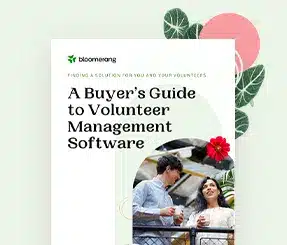10 Tips That Will Help You Create an Engaged Nonprofit Board


Full Platform Overview Chat With Us



Full Platform Overview Chat With Us




Depending on who you ask, your board of directors can be the single most important element in determining your organization’s success or failure. As you’ve likely seen within your organization, board experience matters and board engagement should be a top priority. When board members are engaged, they’re more effective in moving your organization’s mission forward.
Below I’ll talk about engaged boards and how you can build one.
In resource development, one person cannot and should not be expected to play all the distinct roles that are needed for your organization to be successful.
Each member of the resource development team has an important role to play:
The process of engaging your board begins at the recruitment stage. When recruiting for or changing the board, you can’t have a scarcity mindset. How many times have you heard this: “How would we replace them? We don’t have a prospect in the pipeline.”
Remember, serving on a board of directors is a privilege and should be treated as such. Your job is to find someone who will serve on the board, not just sit on it.
The selection of board members should be based on an in-depth look at what the board as a whole needs to round out a well-balanced, highly diverse, and dedicated group of individuals. Those who are invited to join the board should bring a needed expertise or skill set. Their invitation to join the board should not be based on friendship, partnership, relations, or just because they are a “good old boy or good old gal.”
Board members must have a clear understanding of what’s expected of them. This should be discussed at the recruitment stage and further solidified during board orientation.
The orientation is the critical next step in nonprofit board engagement. During the orientation, board members should sign a statement of expectations or agreement that makes their responsibilities clear. Meeting attendance, fundraising requirements, committee participation, and personal giving should all be addressed during orientation.
Next, make sure board members receive feedback on their performance; this can help them improve their performance and make sure they’re meeting your organization’s needs. Sometimes the knowledge that performance is being monitored and shared can spur a change in behavior.
This can be as simple including something like this in their packet:
Fundraising responsibilities shouldn’t fall solely on the ED or your development officer (if you have one). It’s everyone’s job to support fundraising—both board and staff. This is known as a culture of philanthropy.
A culture of philanthropy means that everyone in the organization understands that philanthropy and fund development are critical to the organization’s health and that everyone has a role in the process.
If they haven’t already, board members must make a shift in their mindset and embrace a culture of philanthropy.
All board members should give a personal contribution to the organization. This statement may be controversial to some. Many board members feel that because they donate their time to the organization, they shouldn’t have to donate money as well. However, I believe it’s important that board members give financially to the organization for many reasons.
When board members make a gift to your organization, it shows the board is committed to the organization’s success. In addition, board members tend to be more enthusiastic and interested in the organization’s effectiveness when they have made a significant financial contribution to the organization.
This can be particularly important if board members are involved in soliciting from individuals because it will encourage others to give to the organization. It can seem hypocritical for board members to ask a donor for a contribution if they have not given to the organization themselves; in fact, some foundations want to see 100 percent giving from the board before they give.
In order to engage your board, you must build a relationship with them. Seek out their advice, thank them for investing their time and resources, and make sure you do a listening tour where you spend one-on-one time with each of them getting feedback and assessing their needs. This tour can be done in-person or virtual. The goal is to talk in an informal setting with no agenda so they’re comfortable sharing what they need.
Don’t take your board members for granted. Steward board members by expressing interest in their work and lives. This includes recognizing birthdays, marriages, and other big life events. Implementing these steps will help to boost your board members’ engagement.
The most important tactic is not a one-and-done activity. Boosting board member engagement takes constant attention and ongoing focus. Remember, there is no one-size-fits-all approach. In the end, you must be willing to try new approaches to keep your board engaged.
A nonprofit board is only as strong as the education and direction that they receive. Having a board-approved education plan can take your organization to the next level.
With that in mind, don’t assume your board members understand fundraising or how to talk about your organization. Board education will ensure they have a solid understanding of the underlying philosophy of fundraising, which is building relationships with donors who will stick with your organization for years to come. Board members need and deserve first-rate support from staff.
Start thanking board members from the beginning. During the orientation, present new board members with a certificate of service and take a picture to document the important moment. Advise them to place the certificate in their office where community members see they serve on the organization’s board.
In addition to this, extend a warm welcome to your new board members by sharing the news with your community using the certificate presentation picture or their professional headshot. By making a public announcement, you’re telling new members that you’re proud to have them on your team. Plus, this is an easy way to keep key stakeholders in the loop and let them know that you have new additions to your team. Share the news in your newsletter, on social media, on your website, and in a news release.
No matter how you share the good news, this simple step of officially announcing your team members makes them feel valued, reminds your community of the hard work that goes into fulfilling your mission, and extends the board member’s credibility to your organization.
There are other simple ways you can give board members some prominence. You can list them on your organization’s letterhead and website and feature them in a newsletter or on social media.
Joining a nonprofit’s board can be intimidating. New members may be afraid to ask questions for fear of looking silly. You can ease this process by assigning a board buddy.
A board buddy is a veteran board member who is assigned to sit next to the new member at their first meeting. They can also call the new member before and after the meeting to check in on how they’re doing and see if they have any questions.
You may also want to have an orientation call. With orientation calls, veteran board members set up calls with a class of new members to review and answer any questions they may have post-orientation. This should be done about two months into their board service.
This experience can be just as valuable and enjoyable for the veteran board member as it gives them an outlet to share their passion for your mission, effectively sparking more enthusiasm for their own work. They’ll also be conscious of the fact that they should set a positive example in meetings, which can directly impact their participation and performance.
Figure out how to make your board meetings fun. If run effectively, board meetings can move your nonprofit closer to its strategic goals and fundraising.
Here is what you need to do to run an effective board meeting:
Your nonprofit’s board members are one of your most precious resources. Your nonprofit board members should be doing at least 80% of the talking during the meeting, and that talk should focus mostly on decisions and strategic discussions, not updates and staff reports (except for the absolutely necessary ones). It’s crucial to get board meetings right. A meeting agenda is your board’s most important tool for engagement.
Board members want to be strong advocates and storytellers, but they often don’t have the tools they need to do this well. To ensure your board has firsthand stories about your organization that they can share with others, kick each board meeting off with a mission moment. This should only take up about 5 minutes of the agenda.
In this mission moment, you can have a client tell their nonprofit story to the board. If clients are not available at your meeting time, consider using video testimonials. This is easily accomplished using cell phone video.
The goal of this is twofold. First, it helps the board stay connected to your nonprofit’s purpose. Second, it gives your board several stories they can share in the community and with prospective donors. Having real-life stories that show your mission’s impact is crucial for inspiring donors to give.
Take these tips and turn your board into an engaged one and see how your nonprofit succeeds! I bet you’ll be pleasantly surprised by the results.
You can follow me on Instagram, Facebook, YouTube, LinkedIn, and Pinterest. You can also visit my website at www.supportingworldhope.com.

Discover what nonprofits need in place in order to achieve sustainability.

Comments
Pam Powell
Stephen Peck
Nicole Levine
Tracy
Michael Kumer